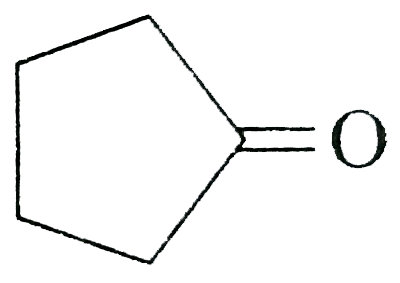Acetone on addition to methyl magnesium bromide forms a complex, which on decomposition with acid gives X and Mg(OH)Br. Which one of the following is X?
CH3OH
(CH3)3COH
(CH3)2CHOH
CH3CH2OH
The correct Answer is:B
To solve the problem, we will follow the steps of the reaction between acetone and methyl magnesium bromide (a Grignard reagent) and identify the product formed after hydrolysis.
1. Identify the Reactants:
- Acetone (CH₃COCH₃) is a ketone with the structure:
CH3−C(=O)−CH3
- Methyl magnesium bromide (CH₃MgBr) is a Grignard reagent.
2. Formation of the Grignard Complex:
- When acetone reacts with methyl magnesium bromide, the nucleophilic methyl group (CH₃⁻) from the Grignard reagent attacks the electrophilic carbon of the carbonyl group (C=O) in acetone.
- This results in the formation of a tetrahedral intermediate:
CH3−C(OH)(CH3)−CH3
- The magnesium bromide ion (MgBr⁺) associates with the oxygen atom, leading to a complex:
CH3−C(OH)(CH3)−CH3+MgBr⁺
3. Decomposition with Acid:
- Upon hydrolysis (decomposition with acid), the tetrahedral intermediate undergoes protonation and rearrangement.
- The negative charge on the oxygen atom is neutralized by a proton (H⁺) from the acid, forming an alcohol:
CH3−C(OH)(CH3)−CH3→(CH3)3C−OH(tert−butylalcohol)
- The magnesium bromide ion combines with hydroxide ions (OH⁻) from the acid to form:
Mg(OH)Br
4. Identify the Product X:
- The product X formed after hydrolysis is tertiary butyl alcohol, which has the structure:
(CH3)3C−OH
Conclusion:
The final product X is tertiary butyl alcohol.
Answer:
X = Tertiary butyl alcohol (Option B)
- Acetone (CH₃COCH₃) is a ketone with the structure:
CH3−C(=O)−CH3
- Methyl magnesium bromide (CH₃MgBr) is a Grignard reagent.
- When acetone reacts with methyl magnesium bromide, the nucleophilic methyl group (CH₃⁻) from the Grignard reagent attacks the electrophilic carbon of the carbonyl group (C=O) in acetone.
- This results in the formation of a tetrahedral intermediate:
CH3−C(OH)(CH3)−CH3
- The magnesium bromide ion (MgBr⁺) associates with the oxygen atom, leading to a complex:
CH3−C(OH)(CH3)−CH3+MgBr⁺
- Upon hydrolysis (decomposition with acid), the tetrahedral intermediate undergoes protonation and rearrangement.
- The negative charge on the oxygen atom is neutralized by a proton (H⁺) from the acid, forming an alcohol:
CH3−C(OH)(CH3)−CH3→(CH3)3C−OH(tert−butylalcohol)
- The magnesium bromide ion combines with hydroxide ions (OH⁻) from the acid to form:
Mg(OH)Br
- The product X formed after hydrolysis is tertiary butyl alcohol, which has the structure:
(CH3)3C−OH
The final product X is tertiary butyl alcohol.
X = Tertiary butyl alcohol (Option B)
Similar Questions
Knowledge Check
Which of the following will give acetone?
AH3C−C≡CHHg+2,H2SO4−−−−−−−−→BCH3−C≡CHB2H6−−−−−→ΘOH,H2OC DHC≡CH+CH3OH→
DHC≡CH+CH3OH→Which one of the following combination gives compound (X)?
 A
A B
B C
C D
D
Methyl cyanide on treatment with methyl magnesium bromide followed by of subsequent hydrolysis gives:
View SolutionTreatment of cyclopentanone
 with methyl
with methyl
lithium gives which of the following species?
View SolutionReaction between acetone and methyl magnesium chloride followed by hydrolysis will give:
View SolutionFormaldehyde when reacted with methyl magnesium bromide followed by hydrolysis gives
View SolutionWurtz reaction of methyl iodide yields an organic compound X. Which one of the following reactions also yields X?
View SolutionThe reaction of methyl magnesium iodide with acetone followed by hydrolysis gives secondary butanol.
View Solution
